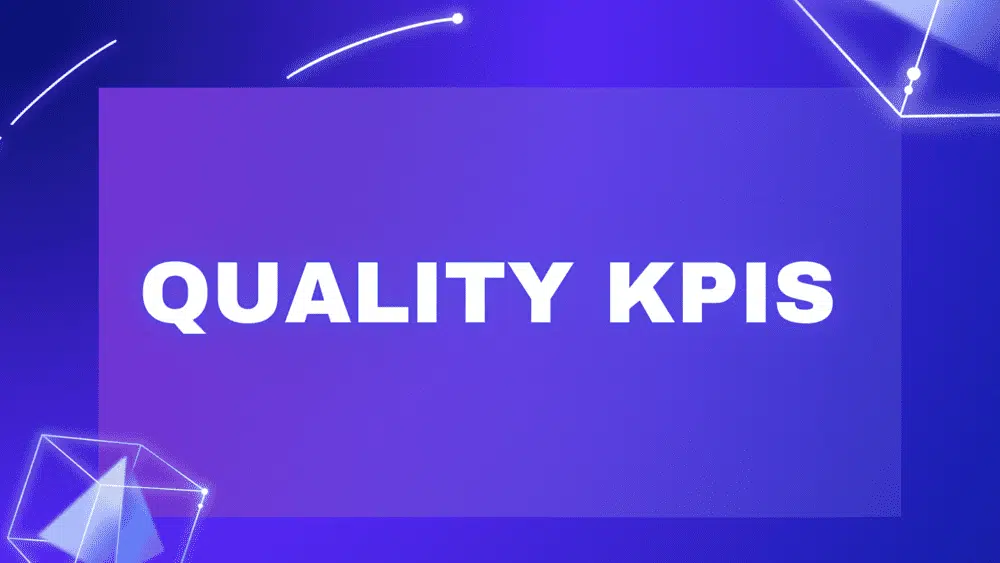Quality is paramount for business growth and sustainability. If your product quality is poor, customers will not buy your product, and you will face many after-sales issues and refunds.
You need to measure quality to ensure product quality, and Quality KPIs (key performance indicators) help you achieve these business objectives.
Today’s blog post will discuss the importance of quality KPIs and provide commonly used KPIs for quality management.
Why Are Quality KPIs Important?
Quality Key Performance Indicators (KPIs) are vital for many reasons.
They provide measurable benchmarks to assess the quality and performance of processes, products, or services. By tracking quality KPIs, you can identify areas where quality may be lacking or improvements can be made.
Quality KPIs drive continuous improvement initiatives by setting quality performance targets and goals, leading to better decision-making. Using KPIs, you can monitor customer satisfaction levels and build trust with customers and stakeholders by consistently meeting or exceeding quality expectations.
KPIs in quality management make the process efficient and ensure a high-quality product. All these reduce costs by minimizing defects, rework, and waste.
Tops 36 Quality KPIs
Here are 36 commonly used quality management KPIs:
- Active Defects: Active defects refer to the number of unresolved flaws identified in products or services. This KPI helps you track ongoing quality issues that require attention to maintain product or service quality standards.
- Average Time to Respond: This KPI measures the average duration it takes to acknowledge a customer complaint or inquiry. It shows the organization’s responsiveness to customer concerns and sets expectations for timely communication.
- Average Time to Solve: The average time to solve indicates the average duration required to resolve customer complaints. It assesses the effectiveness of the organization’s problem-solving processes.
- Complaint Resolution Time: Complaint resolution time measures the time it takes to address and resolve customer complaints from the moment they are reported. This quality KPI shows the organization’s ability to rectify problems and enhance customer satisfaction promptly.
- Cost of Poor Quality (COPQ): COPQ quantifies the impact of defects, errors, and inefficiencies in products or processes. It includes costs associated with internal and external failures, rework, scrap, warranty claims, and customer complaints, thus highlighting areas for improvement to reduce expenses and enhance quality.
- Cost of High Quality (COHQ): COHQ is comprised of the expenses incurred to maintain high-quality standards, including investments in prevention and appraisal activities (e.g., training, quality assurance processes, and technology). It shows the organization’s commitment to delivering superior products or services and minimizing the risk of defects and failures.
- Cost of Quality (CoQ): CoQ includes the cost of achieving good quality (i.e., prevention and appraisal) and the cost of poor quality (i.e., internal and external failures). It provides a comprehensive view of quality-related expenses and helps organizations optimize resources to improve overall quality performance and reduce total costs.
- Customer Complaint Rate: This KPI measures the frequency of customer complaints within a specific period, thus indicating dissatisfaction areas and improvement opportunities. It enables organizations to proactively address customer concerns and enhance the quality of products or services.
- Customer Retention Rate: Customer retention rate calculates the percentage of customers retained over a certain period, thus showing customer satisfaction, loyalty, and the effectiveness of customer-relationship-management strategies. It is a key indicator of business sustainability and long-term success.
- Customer Satisfaction Score (CSAT): CSAT measures customer satisfaction with products or services based on surveys and/or feedback. It provides insights into customer perceptions, preferences, and areas for improvement, thus guiding efforts to enhance overall customer satisfaction and loyalty.
- Defects Per Million (DPM): DPM measures the number of defects found per every million units produced or delivered. This KPI provides a standardized way to assess the quality of a process, product, or service by considering the production scale. Lower DPM values indicate higher quality and fewer defects in the production or delivery process.
- Defects Per Unit: Defects per unit measures the average number of defects identified in each unit of a product or service. It helps to quantify the quality of products or services and identify areas for improvement in the production or delivery process. A lower defect-per-unit value indicates higher quality and fewer defects in each unit produced or delivered.
- Defect Density: Defect density provides the number of defects identified per unit of measurement (e.g., line of code in software development or square meters in manufacturing). It provides insights into the concentration of defects within a specific area or component, thus enabling teams to focus on areas with higher defect density to improve overall quality.
- Defects Fixed Per Day: This KPI measures the average number of defects or issues that employees resolve within a workday. It provides the efficiency and effectiveness of the defect-resolution process, thus indicating the organization’s responsiveness to quality issues and its ability to maintain or improve product or service quality over time.
- Employee Satisfaction: Employee satisfaction measures employee contentment and fulfillment within an organization. It encompasses various factors (e.g., job satisfaction, work-life balance, career-development opportunities, and organizational culture). High employee satisfaction levels often correlate with increased productivity, lower turnover rates, and improved organizational performance.
- Employee Training Hours: Employee training hours quantify the time spent on employee training and development activities within an organization. They reflect the organization’s investment in developing employee skills, knowledge, and competencies to enhance job performance and overall productivity. Higher training hours indicate a commitment to continuous improvement and employee empowerment.
- First Time Quality (FTQ): This quality KPI measures the percentage of products or services that meet quality standards upon initial inspection or delivery without requiring rework or corrective action. It shows the effectiveness of the production or service delivery process in consistently meeting quality requirements and minimizing defects or errors.
- First-Pass Yield (FPY): FPY calculates the percentage of units that pass through a process without requiring rework or correction. It evaluates the efficiency and effectiveness of the production or service-delivery process in achieving quality standards on the first attempt. Higher FPY values indicate better process performance and reduced waste.
- Internal Quality Audit Findings: This KPI measures the results of internal quality audits to assess compliance with quality standards, processes, and procedures. It identifies areas of non-conformance, deviations, or improvement opportunities, thus helping organizations address quality issues and enhance overall quality management practices proactively.
- Net Promoter Score (NPS): NPS is a metric used to measure customer loyalty and satisfaction based on the likelihood of customers recommending your products or services to others. It is calculated by subtracting the percentage of detractors (i.e., customers who are unlikely to recommend) from the percentage of promoters (i.e., customers who are likely to recommend). NPS provides insights into customer perceptions and helps organizations gauge their reputation and potential for growth through positive word-of-mouth recommendations.
- Non-Conformities: Non-conformities represent instances in which products, services, or processes do not meet specified standards, requirements, or regulations. This KPI quantifies the number of deviations from established norms, thus highlighting areas in which corrective action is necessary to ensure compliance and maintain quality standards.
- Number of Complaints Per Period: This KPI measures the total number of customer complaints received within a specific timeframe. It provides insight into the frequency and nature of customer dissatisfaction, thus helping organizations identify recurring issues, prioritize improvements, and enhance customer satisfaction.
- On-Time Delivery: On-time delivery measures the percentage of orders or projects completed and delivered to customers within the agreed-upon timeframe. It reflects the organization’s ability to fulfill customer expectations for delivery schedules, thus demonstrating reliability and commitment to customer service excellence.
- Percentage of Conformance: Percentage of conformance calculates the proportion of products, services, or processes that meet specified quality standards or requirements. It assesses consistency and adherence to established criteria, thus providing insights into the organization’s overall quality performance.
- Percentage of Defective Products: This KPI measures the proportion of products with defects or failing to meet quality standards. It quantifies the extent of quality issues within the production process, thus guiding efforts to reduce defects and improve product quality.
- Process Capability (CPK): Process capability (CPK) evaluates the ability of a process to produce products or services consistently within specified quality limits. It assesses the centering and spreading of process outputs relative to the desired target, thus providing a quantitative measure of process performance and the capability to meet customer requirements.
- Product Reliability: Product reliability measures the ability of a product to perform its intended function satisfactorily over a specified period and under normal operating conditions. It shows product durability, consistency, and trustworthiness, thus influencing customer satisfaction and brand reputation.
- Quality Cost Ratio: This KPI compares the cost of ensuring quality (i.e., prevention, appraisal, and failure costs) to the cost of poor quality (i.e., internal and external failure costs). It helps organizations evaluate the effectiveness of their quality management efforts and identify opportunities to optimize quality-related expenses.
- Rejected Defects: Rejected defects represent the number of defective units or products identified during quality control inspections that are deemed unfit for use or delivery. This KPI highlights quality issues that require corrective action, thus contributing to waste reduction and process improvement efforts.
- Return Rate: Return rate measures the percentage of products customers return due to defects, dissatisfaction, or other reasons within a specific period. It indicates customer dissatisfaction and potential quality issues, thus prompting organizations to investigate the root causes and implement corrective measures to improve product quality and customer satisfaction.
- Rework Rate: Rework rate calculates the percentage of products or units that require additional work or correction to meet quality standards after initial production or delivery. It reflects inefficiencies in the production process and additional costs incurred due to rework, thus guiding efforts to streamline processes and minimize defects.
- Severe Defects: Severe defects refer to significant or critical flaws identified in products or services that can cause substantial harm, safety risks, or major disruptions. This KPI focuses on the most serious quality issues that have the potential to impact customer safety, satisfaction, and brand reputation. Tracking severe defects helps prioritize corrective and preventive measures to mitigate risks and ensure product integrity.
- Scrap Rate: Scrap rate measures the percentage of materials or products discarded or deemed unusable during production. It shows inefficiencies, waste, and quality issues within manufacturing operations. A high scrap rate indicates poor quality control, excessive material waste, and potential cost implications, thus highlighting the need for process improvements and waste-reduction initiatives.
- Supplier Defect Rate: Supplier defect rate quantifies the percentage of defective or non-conforming materials, components, or products received from external suppliers. It assesses the supplier’s quality performance and their ability to meet agreed-upon specifications and quality standards. Monitoring the supplier defect rate helps identify underperforming suppliers, mitigate supply chain risks, and improve product quality and reliability.
- Supplier Quality: Supplier quality evaluates the performance and reliability of external suppliers to deliver materials, components, or services that meet specified quality requirements. It comprises product quality, consistency, reliability, on-time delivery, and issue responsiveness. Maintaining high supplier quality is essential to ensure the quality and competitiveness of the final products or services delivered to customers.
- Warranty Claims: Warranty claims represent customer requests for repairs, replacements, or refunds due to product defects or failures covered by warranty agreements. Tracking warranty claims provides insights into product reliability, durability, and customer satisfaction. High or increasing warranty claims may indicate quality issues, design flaws, or manufacturing defects that require corrective action to enhance product quality and reduce warranty related costs.
Summary
Monitoring quality key performance indicators (KPIs) is important to deliver high-quality products and services. These KPIs help track performance and identify areas for improvement. By actively measuring these metrics, you can pinpoint issues early, fix them quickly, and keep customers happy.

I am Mohammad Fahad Usmani, B.E. PMP, PMI-RMP. I have been blogging on project management topics since 2011. To date, thousands of professionals have passed the PMP exam using my resources.







